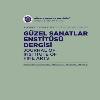Bolu ili arazi kullanım sınıflarına göre toprak üstü biyokütlede depolanan karbon miktarlarının NDVI ile belirlenmesi
Arazi kullanım - arazi değişimi, Toprak üstü biyokütle, Karbon., Landsat, NDVI, Bolu
Determination of carbon storage amounts in above-ground biomass using NDVI based on land use/land cover classes in Bolu
Land use-Land change, Above ground biomass, Carbon, Landsat, NDVI, Bolu,
___
- Asan Ü (1995) Global İklim Değişimi ve Türkiye Ormanlarında Karbon Birikimi. İstanbul Üniversitesi, Orman Fakültesi Dergisi, 45(1-2):23-37.
- Asan Ü (1999) Climate Change, Carbon Sinks and The Forests of Turkey. Proceedings of the International Conference on Tropical Forests and Climate Change: Status, Issues, and Challenges (TFCC ’98), Phillippines, pp.157-170.
- Asan Ü, Destan S, Özkan YU (2002) İstanbul Korularının Karbon Depolama, Oksijen Üretme ve Toz Tutma Kapasitesinin Kestirilmesi, Orman Amenajmanı'nda Kavramsal Açılımlar ve Yeni Hedefler Sempozyumu, 18-19 Nisan, s., 194-197, İstanbul.
- Ariluoma M, Ottelin J, Hautamaki R, Tuhkanen EM, Manttari M (2021). Carbon sequestration and storage potential of urban green in residential yards: A case study from Helsinki. Urban Forestry & Urban Greening, (57), 1-12. https://doi.org/10.1016/j.ufug.2020.126939.
- Arslan ES, and Örücü ÖK (2019) Bodrum İlçesi’nin 1990-2018 Yılları Arasındaki Arazi Örtüsü Değişimi. İçinde Bodrum İlçesi’nin 1990-2018 Yılları Arasındaki Arazi Örtüsü Değişimi (ss. 181- 198).
- Atak BK, Tonyaloğlu EE (2019) Aydın İli Örneğinde Karbon Depolama Potansiyelinin Mekânsal ve Zamansal Analizi, AKU Journal of Science Engineering, 19, (778-786)
- Backéus S, Wikström P, Lämås T (2005) A model for regional analysis of carbon sequestration and timber production. Forest Ecology and Management, 216, 28–40
- Baniya B, Tang Q, Huang Z, Sun S, Techado K (2018) Spatial and Temporal Variation of NDVI in Response to Climate Change and the Implication for Carbon Dynamics in Nepal. Forests, 9, 329; doi:10.3390/f9060329.
- Birdsey RA (1992) Carbon storage and accumulation in United States forest ecosystems. United States Department of Agriculture Forest Service GTR WO-59.
- Brown S, Sathaye J, Cannell M, Kauppi PE (1996). Management of forests for mitigation of greenhouse gas emissions. Commonwealth Forest Review, 75, 80-91.
- CORINE (1997) The CORINE Project. Methodology. European Environmental Agency.
- DPT (2002) Devlet planlama teşkilatı müsteşarlığı, Bolu İl raporu. DPT Yayın No:2651
- Gülersoy AE (2013) Farklı Uzaktan Algılama Teknikleri Kullanılarak Arazi Örtüsü/Kullanımında Meydana Gelen Değişimlerin İncelenmesi: Manisa Merkez İlçesi Örneği (1986–2010). 8 (8), 1915-1934.
- Günlü A, Ercanli I, Başkent EZ, Çakır G (2014) Estimating aboveground biomass using Landsat TM imagery: A case study of Anatolian Crimean pine forests in Turkey. Annals of Forest Research, 57(2), 289-298.
- Güre M, Özel ME, Özcan H (2009) Corine Arazi Kullanımı Sınıflandırma Sistemine Göre Çanakkale İli. Harran Üniversitesi Ziraat Fakültesi Dergisi, 13 (3), 37–48.
- Hussain T, Sarma KK (2019) Above ground Biomass and Carbon Stock Mapping using NDVI and Ecological Studies of woody trees of Jeypore Reserve Forest Assam India. İndian Forester. 145 (7): 614-618.
- IPCC (2006) Guidelines for National Greenhouse Gas Inventories, Agriculture, Forestry and Other Land Use. (4).
- Keleş S, Başkent EZ (2006) Orman Ekosistemlerindeki Karbon Değişiminin Orman Amenajman Planlarına Yansıtılması: Kavramsal Çerçeve ve Bir Örnek Uygulama (1. Bölüm), Orman ve Av Dergisi, 83, 2, 36-41
- Kumar P, Sharma LK, Pandey PC, Sinha S, Nathawat MS (2012) Geospatial strategy for tropical forest-wildlife reserve biomass estimation. IEEE Journal of Selected Topics in Applied Earth Observations and Remote Sensing, 6(2), 917-923.
- Li C, Li Y, Li M (2019) Improving forest aboveground biomass (AGB) estimation by incorporating crown density and using Landsat 8 OLI images of a subtropical forest in Western Hunan in Central China. Forests, 10(2), 104.
- Quéré CL, Canadell G, Ciais P, Moriarty R, Andrew R, Friedlingstein P, Andres B, Boden T, Houghton S, Marland G (2013) Global Carbon Project, International Geosphere-Biosphere Programme.
- Sivrikaya F, Keleş S, Çakır G (2007) Spatial distribution and temporal change of carbon storage in timber biomass of two different forest management units. Environmental Monitoring and Assessment, 132:429-438.
- Stern N (2006) The Stern Review on the Economic Effect of Climate Change Great Britain Cambridge.
- Tang Y, Chen A, Zhao S (2016) Carbon storage and sequestration of urban street trees in Beijing, China. Frontiers in Ecology and Evolution, (4), 1-8. https://doi.org/10.3389/fevo.2016.00053.
- Tolunay D (2011) Total carbon stocks and carbon accumulation in living tree biomass in forest ecosystems of Turkey. Turkish Journal of Agriculture and Forestry, 35:265-279.
- TUIK (2021) Turkish Statistical Institute. Ankara, Turkey.
- USGS (2021) Landsat Missions, (Landsat 5, Landsat 8). Erişim tarihi:7/09/2021, at https://www.usgs.gov/core-science-systems/nli/landsat.
- Üyük A, Uzun A. Çardak Ç (2020) Corine verileri ile Değişim analizi, Denizli İli örneği. Turkish Journal of Landscape Research, (Türkiye Peyzaj Araştırmaları Dergisi) 3:2, 97-107.
- Watson RT, Noble IR, Bolin B, Ravindranath NH, Verardo DJ, and Dokken DJ (2000) Land use, Land-use change, and forestry, Cambridge University Press, Cambridge.
- Yıldırım E, Ortaçeşme V (2016) Manavgat Nehri Havzası’ndaki peyzaj değişiminin peyzajların korunması, planlanması ve yönetimine yönelik değerlendirilmesi. Mediterranean Agricultural Sciences, 29(2).
- Yolasığmaz HA (2004) Orman Ekosistem Amenajmanı Kavramı ve Türkiye’de Uygulaması, Doktora Tezi, K.T.Ü., Fen Bilimleri Enstitüsü, Trabzon
- Zengin H, (2007) Küresel Isınmanın Önlenmesinde Ormanların Rolü ve Önemi.
- Zheng G, Chen JM, Tian QJ, Ju WM, Xia XQ (2007) Combining remote sensing imagery and forest age inventory for biomass mapping. Journal of Environmental Management, 85(3), 616-623.
- Zheng D, Rademacher J, Chen J, Crow T, Bresee M, Le Moine J, Ryu SR (2004) Estimating aboveground biomass using Landsat 7 ETM+ data across a managed landscape in northern Wisconsin, USA. Remote sensing of environment, 93(3), 402-411.
- Zhu X, Liu D (2015) Improving forest aboveground biomass estimation using seasonal Landsat NDVI time-series. ISPRS Journal of Photogrammetry and Remote Sensing, 102, 222-231.
- ISSN: 2146-1880
- Yayın Aralığı: 2
- Başlangıç: 2000
- Yayıncı: Artvin Çoruh Üniversitesi Orman Fakültesi
Temel GÖKTÜRK, Medea BURJANADZE, Göksel TOZLU
Gül Nur KARAL NESİL, Nebiye MUSAOĞLU
Ekolojik koridorlarda peyzaj yapısının ve değişiminin tanımlanması: Sazlıdere-Küçükçekmece örneği
Burdur kenti bulvar ve caddelerindeki odunsu bitki envanterinin çıkarılması ve değerlendirilmesi
Orman ağacı ıslah çalışmalarında doğrusal karma model seçimi
Ahmet Salih DEĞERMENCİ, Hayati ZENGİN
